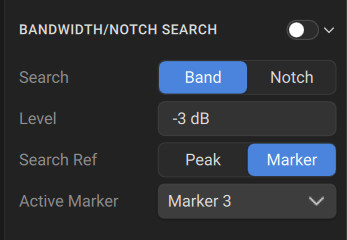The bandwidth search function allows to determine and view the following parameters of a passband or a stopband: bandwidth, center frequency, lower frequency, higher frequency, Q value, and insertion loss.
The bandwidth search is executed from the reference point. The active marker or the maximum trace value can be selected as the reference. The bandwidth search function detects lower and higher cutoff frequencies that differ from the reference point response by a user-specified bandwidth value (usually – 3 dB).

Bandwidth Search
Bandwidth parameters
Parameter Description |
Symbol |
Definition |
Formula |
|---|---|---|---|
Bandwidth |
BW |
The difference between the higher and lower cutoff frequencies. |
F2 – F1 |
Center Frequency |
cent |
The midpoint between the higher and lower cutoff frequencies. |
(F1+F2)/2 |
Lower Cutoff Frequency |
low |
The lower frequency point of the intersection of the bandwidth cutoff level and the trace. |
F1 |
Higher Cutoff Frequency |
high |
The higher frequency point of the intersection of the bandwidth cutoff level and the trace. |
F2 |
Quality Factor |
Q |
The ratio of the center frequency to the bandwidth. |
cent/BW |
Loss |
loss |
The trace measured value in the reference point of the bandwidth search. |
— |
|
To enable/disable bandwidth search function: Search > Bandwidth/Notch Search And use the toggle to turn it ON/OFF. |
|
Set the bandwidth search type by: Search > Bandwidth/Notch Search > Search [Band | Notch] |
|
To set the bandwidth search level: Search > Bandwidth/Notch Search> Level Then either type in the desired level or use the arrows in the textbox. |